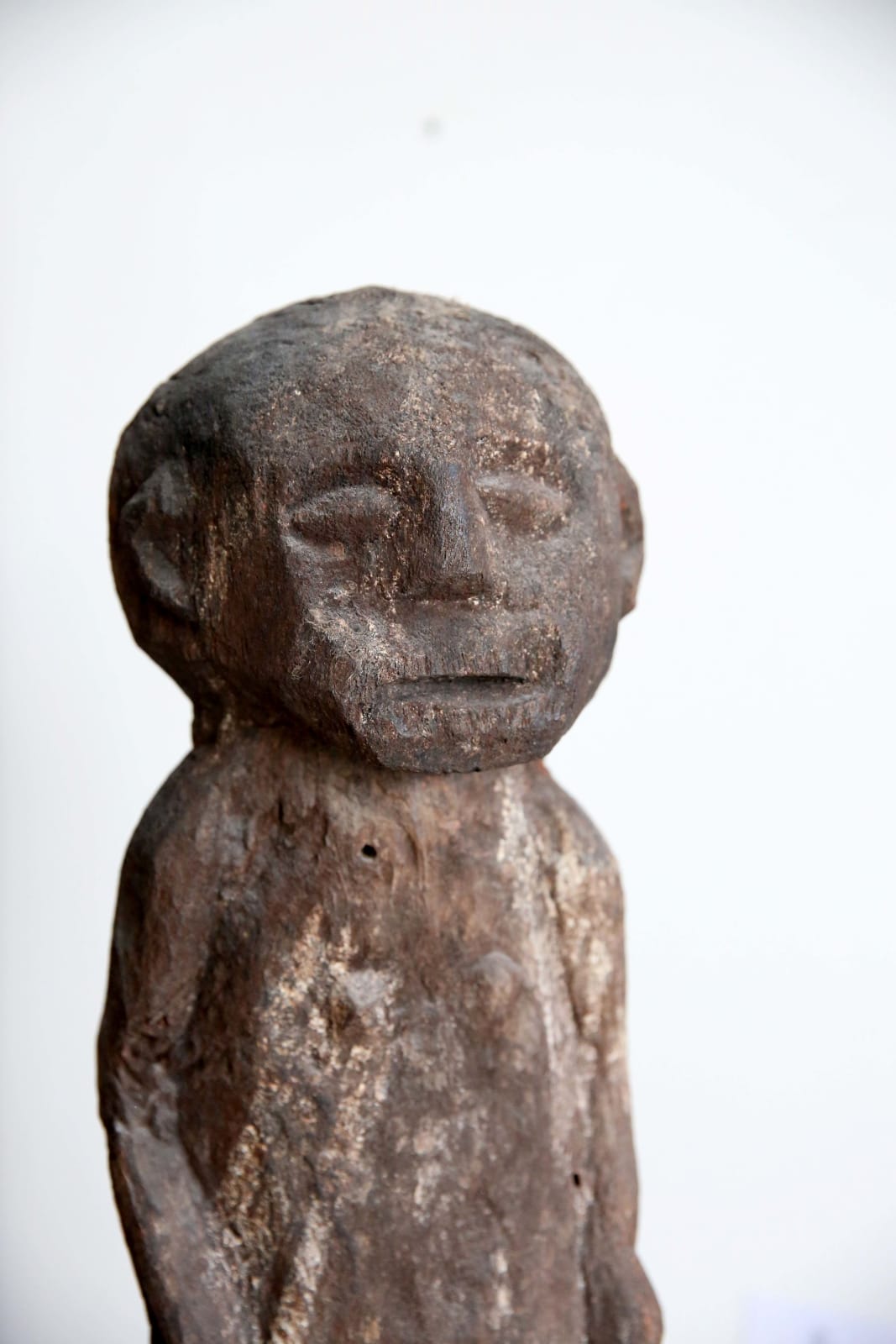Anonymous Fon artist
height 27 1/2 in
Further images
This powerful bocio statue was acquired from the Fon healer Legbassi Affodo in the village of Mougnon by the Belgian art dealers Ann De Pauw and Luc Husyveld in September 1994. The statue was positioned in a small bush in a little square in the center of the village. Legbassi Affodo identified the statue as Sakpata, one of the most important deities of the Fon pantheon, the god of the earth, who rules the world. Sakpata provides people with honey, corn, and all the seeds that come from the earth. But when he wants to punish people, he makes all these seeds come out of their skin, giving them smallpox – hence he’s also often called the god of smallpox; he is both the god of life and the god of death. Affado had known the statue his whole life, placing its creation in the early decades of the twentieth century, or earlier. Initiations would traditionally take place in front of this bocio, and every year a sheep would be sacrificed to it.
The word vodun originates from the Fon peoples, who lived in old kingdom of Dahomey (now situated in the Republic of Benin). Vodun is, first and foremost, an affirmation of the existence of a supernatural world. Secondly, it comprises a system of diverse procedures for communicating with this world. At the head of the pantheon is Mawu, the supreme god, who is surrounded by adjunct gods grouped together in a hierarchical pantheon. The important nature gods are accompanied by an entire spectrum of deified beings: clan ancestors, monsters, the gods of conquered groups, etc. Humans and gods resemble each other and need each other: humans need the indulgence and favors of the gods, while the gods need offerings and sacrifices from humans. Apart from Mawu, all the gods can be represented by “fetishes”, often taken the shape of anthropomorphic wooden statues such as the present. A “fetish” – as it was called by the first Portuguese observers – is a sacred object which embodies the spirit of the force of a god. It is not a representation or a portrait of that god, but rather an object that is a receptacle for the god’s power. Called bocio, these statues receive periodical offerings and sacrifices. They are fed palm oil and animal blood to revitalize the powers they contain, and establish a connection between the visible and invisible world. Bocio act as sentries; they protect a village, a neighborhood, a lineage, a family, or an individual. Their job is to ward off any danger that may come from the outside, as well as to dissipate any source of discord, division, or conflict within a group. They maintain order and ensure harmony. As Malraux wrote: “Voodoo involves being on everyday terms with the supernatural”. Positioned on an open square in the village a bocio could easily detect danger and protect the village from devastating plagues. In addition to its collective aspect, these powerful objects may also be used for individual aggressive or defensive purposes, as a means of neutralizing or protecting oneself from an adversary. The Fon scholar Susan Preston Blier has suggested bocio often look raw and brutal in part because they speak to the deep and difficult emotions that continue to challenge us in living life to its fullest. In psychological terms, these works speak to the challenges and fears of the world as it is experienced, a world rife with circumstances and events of the unknown. Bocio address potent fears of the unpredictable.
Susan Preston Blier eloquently explained the origins of the word “Vodun” in the catalog to the 2011 “Vodun” exhibition at the Foundation Cartier in Paris. She writes: “The word’s origins lie in the phrase “rest to draw the water”, from the Fon verbs vo “to rest” and dun “to draw water”, referencing the necessity to remain calm when facing whatever difficulties may lie in one’s path. According to Vodun philosophy, life is like a pool that humans find in the world into which we are born. Patience and calm are necessary if we are to effectively draw from the pool of water that defines our lives, if we are to conduct our lives in a manner that will bring one greatest fulfillment. Rather than simply rushing through life, it is incumbent upon one to keep one’s composure and to take the time to “breathe”. Following on the tradition of local women who will sit quietly by the side of the spring or river before collecting the daily water, in Vodun belief one is encouraged to take time for reflection. Like the serene, straight-standing human figure that serves as the base and center of bocio, encumbered often by potent additive materials, one is encouraged in these bocio and vodun traditions to draw on one’s inner strength and serenity as one pursues one’s course in life. The ethos of Vodun thus has meaning for all of us” (p. 193).
Provenance
Acquired by Ann De Pauw and Luc Husyveld from the Fon healer Legbassi Affodo in 1994
Galerie Amma, Antwerp, March 2011
Private Collection, Antwerp, 2011-2023









